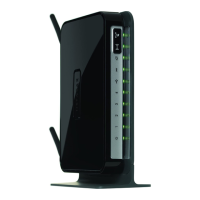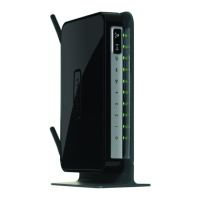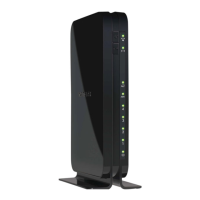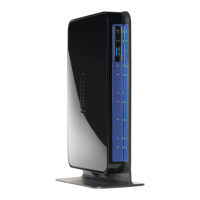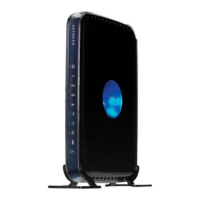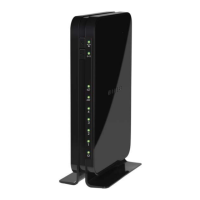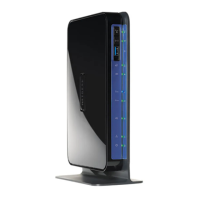How to turn on WiFi LED on NETGEAR Wireless Router?
- JJeremy BoyerSep 12, 2025
If the WiFi LED is off on your NETGEAR Wireless Router, verify that the 'Enable Wireless Router Radio' check box is selected on the Wireless Settings screen.
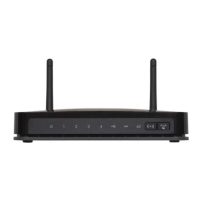
How to turn on WiFi LED on NETGEAR Wireless Router?
If the WiFi LED is off on your NETGEAR Wireless Router, verify that the 'Enable Wireless Router Radio' check box is selected on the Wireless Settings screen.
Why does my NETGEAR DGN2200M show the date as January 1, 2000?
If the date shown on your NETGEAR Wireless Router is January 1, 2000, it means the router hasn't successfully reached a network time server. Check that your Internet access is configured correctly. If you have just configured the router, wait at least 5 minutes and check the date and time again.
How to adjust time on NETGEAR DGN2200M if it's off by one hour?
If the time is off by one hour on your NETGEAR Wireless Router, select the 'Adjust for Daylight Savings Time' check box in the Schedule screen.
| Ethernet LAN | Yes |
|---|---|
| Cabling technology | 10/100Base-T(X) |
| Networking standards | IEEE 802.11b, IEEE 802.11g, IEEE 802.11n, IEEE 802.3, IEEE 802.3u |
| Ethernet LAN data rates | 10, 100 Mbit/s |
| Ethernet LAN interface type | Fast Ethernet |
| Wi-Fi standards | 802.11b, 802.11g, Wi-Fi 4 (802.11n) |
| Top Wi-Fi standard | Wi-Fi 4 (802.11n) |
| WLAN data transfer rate (max) | 300 Mbit/s |
| Bandwidth | 2.4 GHz |
| Security features | IDS, DoS |
| Dimensions (WxDxH) | 173 x 128 x 33 mm |
| Minimum system requirements | IE 5.0+ |
| Compatible operating systems | Windows 7 Windows Vista Windows XP Windows 2000 Mac OS |
| WLAN data transfer rates supported | 11, 54, 150, 300 Mbit/s |
| DHCP client | - |
| Supported network protocols | TCP/IP, DNS |
| Antennas quantity | 2 |
| Ethernet LAN (RJ-45) ports | 4 |
| Security algorithms | WEP, WPA, WPA-PSK, WPA2, WPA2-PSK |
| Certification | CEC, RoHS, WEEE |
| Cables included | Phone (RJ-11), USB |
| Product color | Black |
| LED indicators | LAN, Power, USB, WLAN, Y |
| Weight | 300 g |
|---|
Overview of the router's physical components and their functions, including the router stand.
Guidelines for positioning the router and understanding typical network configurations.
Instructions for accessing the router's web interface for configuration and status checks.
Guide to configuring internet and wireless network settings using the automated setup wizard.
Steps for manually setting up internet connection parameters like broadband and ADSL settings.
Information on ensuring client devices are compatible with the wireless network.
Details on preset security, basic wireless security, and available security options.
Methods for connecting devices to the wireless network via manual or WPS methods.
Explanation of the screen for viewing and changing wireless network parameters.
Instructions on how to set up a separate wireless network for guests.
Procedures for changing the router's administrator password and login timeout period.
Options for blocking keywords, websites, and services to filter internet content.
Setting times and schedules for firewall services to control network access.
Configuring email alerts for security events detected by the router.
Overview of the web filtering solution for controlling family internet content.
Instructions for upgrading the router's firmware and manually checking for updates.
How to back up, restore, and erase router configuration settings.
Viewing current router status, connection details, network statistics, and attached devices.
Using diagnostic tools, rebooting the router, and configuring remote management.
Specifications for USB drives and examples of file sharing use cases.
Configuring basic network access, advanced options, and creating network folders.
Safely removing USB drives, approving devices, and accessing remotely.
Configuring WAN parameters, DMZ, DNS, LAN IP, and DHCP server settings.
Advanced wireless options, SSID hiding, MAC filtering, and WPS configuration.
Configuring static routes, UPnP, wireless bridging, and repeating networks.
Configuring firewall rules to allow internet traffic to local servers or applications.
Monitoring and controlling internet traffic volume with limits and usage statistics.
Verifying power, LED status, and basic connectivity for the router.
Resolving problems with router access, internet connection, and DSL/mobile broadband.
Troubleshooting PPPoE/PPPoA connections and general internet browsing problems.
Using ping utility, restoring default settings, and resolving date/time issues.
Detailed technical specifications including protocols, power, and environmental factors.
Table outlining the router's default settings for various features.
General notes on operating the product according to national and international regulations.
FCC, Canadian, and GPL license information for product operation.
Recommended minimum distances between the router and household appliances.
